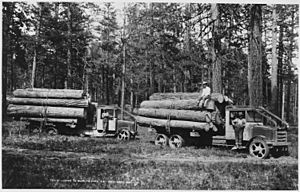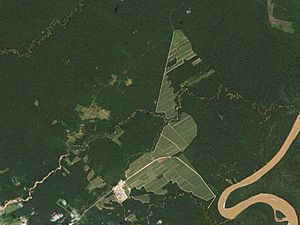Deforestation and climate change facts for kids
Deforestation means clearing forests. It changes land from being covered in trees to having no trees. This can happen naturally, like with wildfires, or by humans. People clear forests for farming, raising animals, or cutting down trees for wood. When we remove more trees, the effects of climate change get worse. Things like wildfires and big storms can also cause more deforestation.
Forests cover about one-third of Earth's land. Every year, a huge area of forest is lost. For example, between 2019 and 2020, the loss of important tropical forests increased by 12%. Growing forests are like a "carbon sink." This means they can absorb and store carbon. This helps to slow down climate change.
Contents
How Deforestation Affects Our Climate
Removing forests forever would make the global surface temperature rise permanently. The Amazon rainforest, for example, used to absorb a lot of carbon dioxide. But because of deforestation, it now absorbs 30% less than it did in the 1990s.
Scientists have studied the Amazon rainforest. They found that if temperatures rise by 4°C or if 40% of the forest is cut down, there could be terrible effects.
Less Help from Nature
When humans clear forests for things like grazing animals or getting wood for fuel, it harms the forests. This also leads to a loss of different plants and animals. Losing forests and their natural life directly impacts climate change. Forests are our best natural defense against too much carbon dioxide in the air.
Forests are Earth's natural carbon sink. Plants take in carbon dioxide, which is a greenhouse gas, from the air. They turn it into sugars and plant material through a process called photosynthesis. This carbon is then stored in the trees, other plants, and the soil. Studies show that healthy forests really do store carbon. Large forests like the Amazon and the Central African rainforests are very important for balancing carbon. But deforestation stops this important process.
When trees are burned or cut down, the stored carbon is released back into the air. This adds more greenhouse gases, like carbon dioxide, to our atmosphere. Deforestation also changes how much sunlight Earth's surface reflects. This is called Albedo. When forests are gone, the ground absorbs more heat from the sun. This makes global warming worse.
Also, as the climate changes, animals and plants need to find new places to live. They try to find areas with the right temperature and humidity. Humans will also be affected by losing different species. Our food, energy, and other natural resources could be disrupted.
Changes in Rainfall Patterns
Climate change can lead to less rain. This means hotter, drier weather and longer dry seasons. These changes have big impacts on nature and the world. They can cause more frequent and severe fires. They can also disrupt pollination, which is how plants reproduce. These problems can spread far beyond the deforested areas.
More Forest Fires
There is a clear link between forest fires and deforestation. If climate change continues without action, by the end of this century, much of the Amazon could be at risk. Fires could make it easier for grass to take over after a fire.
How We Can Control Deforestation
We can try to reverse the effects of deforestation. This includes reforestation, afforestation, and agroforestry.
Afforestation means planting trees where there were no trees before. While this helps reduce carbon emissions, letting nature regrow forests often works even better.
Agroforestry is a way of farming that mixes trees or shrubs with crops or pastureland. It combines farming and forestry methods. This creates more diverse, productive, and sustainable ways to use land.
Important Policies and Programs
Reducing Emissions from Deforestation
One important plan is called REDD+. This stands for "Reducing Emissions from Deforestation and Forest Degradation." It's a global effort to help developing countries protect their forests.
The Bali Action Plan
The Bali Action Plan was created in 2007 in Indonesia. It came from the Kyoto Protocol of 1997. A key part of this plan is for countries to work together. They want to create policies that encourage reducing emissions from deforestation in developing countries. It also stressed the importance of managing forests sustainably. This helps fight climate change and provides more resources to developing nations.
Trillion Tree Campaign
The Billion Tree Campaign started in 2006. The United Nations Environment Programme (UNEP) launched it to fight global warming and other problems. These problems include water shortages and losing different species. Their first goal was to plant one billion trees in 2007.
By 2008, the goal was raised to 7 billion trees. This target was met before a climate change meeting in Copenhagen in 2009. By 2011, over 12 billion trees had been planted. UNEP then handed the program over to a group called Plant-for-the-Planet.
The Amazon Fund (Brazil)
The Amazon Basin is the largest area of biological diversity in the world. It covers almost half of Brazil and two-fifths of South America. This huge area has the largest river system on Earth. About one-fifth of the world's fresh water flows through it. Cutting down trees in the Amazon is a major cause of climate change. Fewer trees mean less carbon dioxide can be captured from the air.
The Amazon Fund collects donations to help prevent and fight deforestation. It also supports protecting and using forests sustainably in the Amazon Biome. The Norwegian Government was the biggest donor. However, they stopped funding in 2019 due to concerns about deforestation. Norway said they would restart funding if Brazil showed a reduction in deforestation.
The Amazon Fund supports many areas. These include managing public forests and protected areas. It also helps with environmental control and inspections. The fund promotes sustainable forest management and economic activities that use forests responsibly. It also helps recover areas that have been deforested. The Amazon Fund can use some of its donations to help other tropical countries monitor deforestation.
Images for kids









